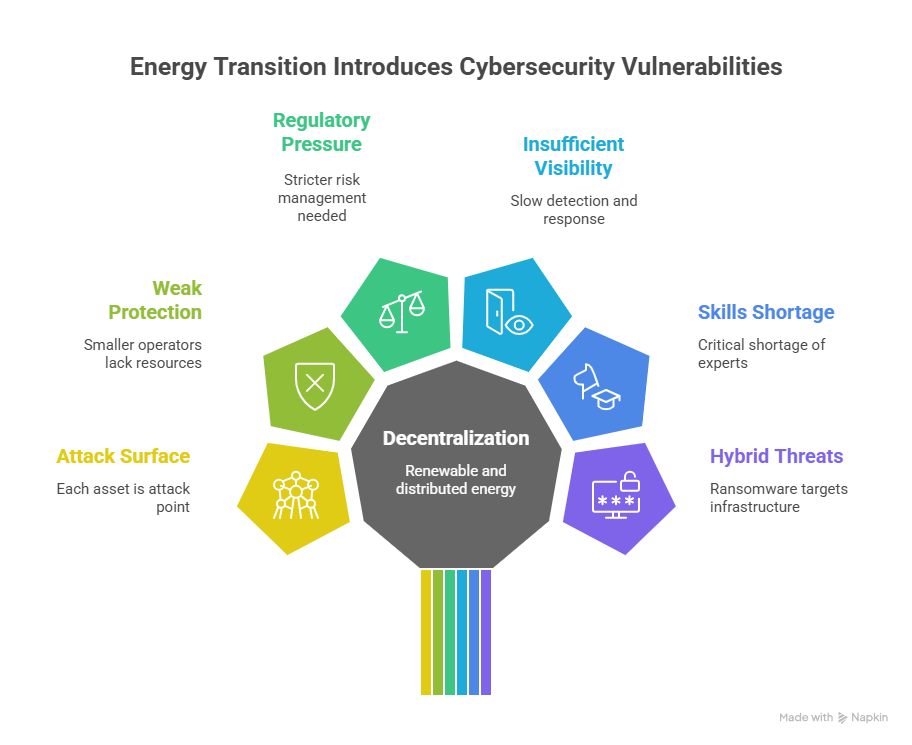As Germany advances toward a more digital, decentralized, and sustainable energy future, the sector faces growing cybersecurity challenges. The energy industry is a key element of national infrastructure, and any disruption – whether from ransomware, insider threats, or foreign attacks – can have devastating economic and social consequences.
In our new article we explore the most critical cybersecurity issues in Germany’s energy industry and present practical strategies to address them.
1. Decentralisation and digitalisation cause vulnerabilities
Germany’s energy transition (“Energiewende”) is accelerating the shift to renewable and decentralized energy generation – solar parks, wind farms, and smart grids. While this decentralisation improves sustainability and efficiency, it also introduces new cybersecurity vulnerabilities. Each connected asset – smart meter, substation, or digital control platform – represents a potential attack point. Many systems were not designed for modern cybersecurity, and rapid digitalisation often exceeds security investments.
To address these risks, energy providers should adopt Zero Trust architectures to authenticate all connections across IT, OT, and cloud systems. Comprehensive cyber risk assessments are conducted before integrating new assets, and network segmentation isolates critical systems from less secure networks to limit potential impact.
2. Weak protection for smaller / distributed energy resources
Smaller and mid-sized operators such as local grid companies, renewable cooperatives, and municipal utilities, often lack the resources for robust cybersecurity programs. Their distributed systems can become easy entry points for attackers targeting larger networks.
To mitigate this, many organizations should adopt Managed Security Services or partner with specialized providers capable of monitoring and protecting distributed networks around the clock. Implementing Privileged Access Management (PAM) tools allows operators to control and audit administrative access, ensuring that only authorized personnel can modify or manage critical systems.
3.Regulatory pressure – NIS-2, KRITIS, EnWG
Germany’s energy companies are subject to cybersecurity regulations, such as NIS-2, KRITIS (Ordinance on the Identification of Critical Infrastructures), and the Energy Industry Act (EnWG). These frameworks demand stricter risk management, documentation, and faster reporting of incidents – sometimes within 24 hours. While these regulations raise security standards, they also place heavy demands on processes, tools, and teams, especially for smaller operators struggling with compliance complexity.
For that reason, organizations should implement Identity Governance and Administration (IGA) systems that maintain audit-ready access records and track user activity across systems. They also automate incident detection and reporting workflows, ensuring that notifications can be submitted in compliance with NIS-2 timelines. Regular review and updating of compliance procedures helps align security practices with the legal requirements, minimizing regulatory risk while maintaining operational continuity.

4. Incident detection, response and visibility are insufficient
Many energy providers still rely on outdated or siloed monitoring systems, resulting in slow detection and response to cyber incidents. The lack of integration between IT and OT environments further obscures visibility, allowing attacks to go unnoticed until significant damage occurs.
To overcome this, organizations should deploy Security Information and Event Management (SIEM) systems alongside Security Orchestration, Automation, and Response (SOAR) platforms. These tools enable centralized monitoring across IT, OT, and cloud assets, providing real-time insight into suspicious activities. In addition, regular penetration testing and threat simulations strengthen response capabilities by identifying weaknesses before attackers can exploit them.
5. Skills shortage
The German energy sector faces a critical shortage of cybersecurity experts. Smaller operators are particularly affected, as skilled professionals often prefer larger enterprises or tech companies. The result is overburdened teams, inconsistent security practices, and a reliance on external support. To mitigate this, companies must invest in staff training and awareness programs. Building internal expertise in cybersecurity best practices, combined with clear operational procedures, empowers employees to act confidently in the face of threats. This strengthens organizational resilience and reduces reliance on external experts.
6.Hybrid threats and ransomware target critical infrastructure
Cybercriminals increasingly target energy infrastructure. Ransomware, phishing, and hybrid attacks can disrupt power supply, manipulate data, or damage reputation. To protect against these threats, energy providers must implement continuous patch management to stay ahead of emerging attack vectors. It’s essential to rely on segmented backups and disaster recovery plans to restore operations quickly in case of an incident. Additionally, the deployment of multi-factor authentication (MFA) and strong encryption across all access points ensures that critical systems remain secure against unauthorized access and ransomware attacks.
Cybersecurity as a national priority
Cybersecurity in Germany’s energy sector must be turned from a technical issue into a national priority. It is essential to balance digital innovation with robust protection, collaboration, and continuous improvement. By combining advanced IAM and PAM solutions with regulatory compliance, employee training, and proactive risk management, energy providers can build resilient and secure infrastructures that support both operational excellence and public trust.
If your organization is looking for a trusted IAM partner to enhance your cybersecurity resilience and support scalable, long-term compliance, don’t hesitate to get in touch with us. We are here to help you turn information security into a true business advantage.

